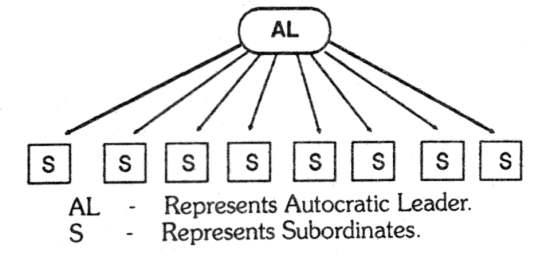Autocratic Style leadership | Meaning | Advantages | Disadvantage

Table of Contents
What is Autocratic Style Leadership?
Autocratic style of leadership is also known as ‘Leader-centered Style‘ or ‘Authoritarian Style‘. Under this style, leader concentrates all authority in himself, instructs subordinates as to what to do, when to do it; how to do it, etc. He also exercises close supervision and control over his subordinates. Subordinates are expected to do what they are told.
The autocratic leader accomplishes the results through the use of authority, fear of deprivation, punishment and such other negative rewards. As it is negative in character, authoritarian approach will succeed only in the short run.
Diagramatic representation of Autocratic Leadership Style

Here ‘AL’ represents Autocratic Leader & ‘S’ Represents Subordinates.
Advantages of Autocratic Style of leadership
Advantages of autocratic style of leadership are:
1. It provides for quick decision-making because here only one person i.e., the leader takes decisions.
2. Mostly subordinates like to work under centralized authority and strict supervision.
3. As there is no consultation with subordinates, confidential matters can be kept secretly.
4. Leadership gives strong motivation and satisfaction to the leader who dictates terms.
5. At lower levels, only less competent subordinates are required.
6. This style may yield positive outcome if great speed is needed.
Disadvantages of Autocratic Style of Leadership
1. The basic problem with the autocratic style of leadership is that subordinates are not informed about why they are asked to do a particular work i.e., the purpose for which the work is required to be preformed.
2. Jobs are assigned, facilities provided, instructions issued without consulting the person who is performing the job.
3. Subordinates are forced to follow the directions given by the leader blindly though the directions given may not be of proper one. This will ultimately produce feelings of helplessness and frustration among the employees.
4. The success of this type of leadership depends entirely upon the efficiency of the leader.
5. Subordinates tend to evade responsibility and initiative.
6. Full potential of subordinates and their creative ideas are not utilized.
7. Organizational continuity is threatened in the absence of the leader. This is because, subordinates get no opportunity for their development.

